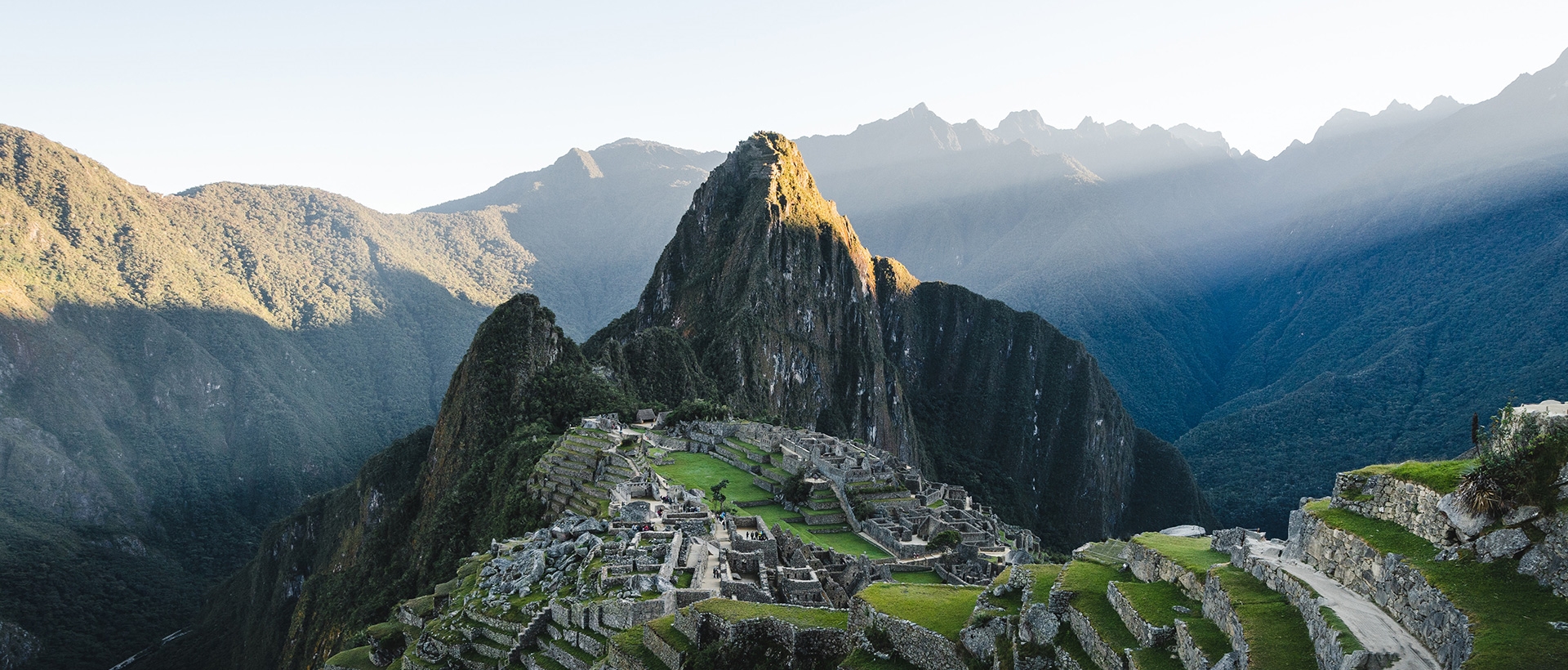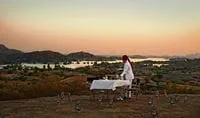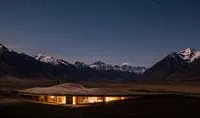When is the Best Time to Visit Peru?
The best month to visit Peru varies across the country so whether you want to trek your way through the lush rainforest and stunning scenery or take in Peru’s vibrant cultural cities, there’s something to enjoy year-round.
- Luxury holidays to Peru at the best time to visit
- Expert advice on when you travel, from the UK’s best travel specialists
- Bespoke tours and experiences with expert guides all year round
- Seamless support, 24/7, whatever the weather

Weather can make a big difference to your holiday in Peru, which has two main seasons: wet and dry. The rainy season in Peru is generally from November to March, which sees warmer temperatures with the odd shower, while the dry season is from April to October where you can expect sunny days and clear, blue skies.
However, for a country like Peru, which is long and narrow, the weather isn’t as clear-cut as that, and it changes from north to south, plus from mountains to deserts, and beaches to jungles. Peru’s diverse landscapes each come with their own specific climate. Read more about the various weather patterns and when the best time to visit Peru is in our travel guide below.
Our Experts Say...
"Whilst Peru can be visited all year round, given its varied and dramatic landscapes, from snow-peaked mountains to tropical jungles, the weather can vary between destinations. The mountainous region of the Andes, where you’ll find the country’s main highlights such as Cusco, Machu Picchu and Lake Titicaca, are best to visit from May to October, whilst December to February can be quite rainy. July and August are peak dates with lots of international visitors, so unless you are bound by school holidays, we’d suggest visiting in the months on either side to avoid the crowds. Being a largely Catholic country, you’ll find plenty of action around Christmas and Easter and the Inca festival of Inti Raymi on 24 June is a great time to enjoy Peru at its most colourful!"
Konrad Mludzinski, Latin America Specialist
Monthly Climate Guide for Peru
, Peru
Average temperatures (Celsius) and rainfall (mm)
Peru’s coastal areas around Lima experience a subtropical climate – warm and sunny in the summer months, which run from December to March, and cool and foggy in the winter, from June to September. However, despite that, the weather doesn’t change a huge amount, with spring-like conditions (mid-20s) most of the year and very little rainfall. It’s best to avoid the wettest months on the coast in February and March, instead, the best time to travel to central Peru is December to March.
In the north of the country, where you'll find the Amazon, there's a more tropical climate, which is hot and rainy all year round. Temperatures range from 31-35˚ C throughout the year, with the dryest period between June and September, making this the best time to visit northern Peru. November to April is the wet season and can be a challenging time to travel due to flooding and slippery walking trails.
With the Andes running up the full length of Peru, the mountain range’s climate changes from top to bottom. It is rainy and warm in the north near the Amazon, colder, with some rainfall in the south, and dry in the middle. In the southern Andes, near the Atacama Desert, temperatures can drop to as low as -25˚ C.
Around Cusco, Machu Picchu and Arequipa, the dry months of May to October are the best times to visit, although the nights can get very cold in June and July. December to March is the rainy season here.
Seasonal Guide for Visiting Peru
Peru is in the southern hemisphere, so its seasons are the opposite of Europe, being warmer in the winter and cooler in the summer. However, Peru’s two distinct seasons are the wet season and the dry season. Here’s how to navigate these two seasons for the best time to travel to Peru and the best things to do while there.
Best Times to Go to Peru for…
Peru is a land of contrasts, with a varied and beautiful landscape that incorporates rainforests, mountains, lakes and beaches. The best time of year to visit Peru will change slightly depending on what you’d like to experience, and where you’d like to visit. But overall, May to October are the best months and overlap with the dry season in the south and central part of the country. Read on for more tips about how to see the best of Peru.
Exploring Peru’s Prime Locations
Peru’s star attraction, Machu Picchu, is best seen between May and October when the country is experiencing its dry season. Rainfall in and around Cusco and its iconic sights starts to increase from November. So, while the temperatures are higher in November to April, there is more rainfall. What’s more, the cooler temperatures make for better hiking weather if you’re embarking on the iconic Inca Trail.
These spring-like temperatures range between 19˚ C and 22˚ C and come with bright blue skies, and strong sun as you reach higher altitudes, despite the mild weather. June to August is the peak tourist season, so to find quieter trails, visit Peru in May or September/October. June to August is also the best time to visit other parts of the Andes with the clear, consistent weather allowing treks to take place, without risk of cancellation due to bad conditions.
Lima’s climate differs from Cusco and Machu Picchu’s. Being central to the country, it is mild all year round, with very little rainfall. April to December is the best time to go to Peru’s capital, after the rainy months of February and March. Crisp, clear skies and a comfortable heat are ideal for walking around the cosmopolitan city, which is rich with world-class cuisine, history and beautiful architecture, best seen on foot.
The Amazon naturally has a climate typical to the rainforest so you should expect rain all year round. However, the best time to visit is from July to September, when it is at its driest. Travelling to the Amazon at its wettest time of year (November to January) can be logistically difficult due to the nature of the roads, which become muddy and often flooded.
Peak and Off-Peak Seasons
May to October is the peak season, when it is considered the best time of year to visit Peru, with the biggest crowds seen in July and August. While those months might bring with them great weather for sightseeing and hiking because of a low level of rain, it does mean that popular sights are very busy, hotels are more expensive and need booking further in advance. By travelling outside the peak months, in May/June and September/October, you will benefit from quieter attractions and better accommodation options.
To avoid crowds at places like Machu Picchu, try to arrive as early as possible. The site opens at 5:30 am for the first visitors and seeing the sunrise over the Inca monument is an extremely special sight. Scott Dunn will be able to secure your tickets to the attraction in advance, so you don’t have to queue to get in and have a head start on the other tourists. Equally, if you arrive at Machu Picchu following a trek, you will be able to beat the crowds as you will enter via a separate gate and be able to get in very early.
Experiencing Peru's Cultural Festivities
Peru's festivals will introduce you to the captivating ancient customs that have been passed through the generations since the Incan times. Traditional food, clothes, songs, and dances all play a part in telling the stories of Peru’s history through colourful celebrations that take place throughout the year. Peruvians love a festival, and you’ll find at least one a month, however some of the biggest take place around Lent and Easter.
While it's challenging to rank the most significant festivals, here are three that are widely celebrated:
Inti Raymi (Festival of the Sun)
Inti Raymi is one of the most important and traditional festivals in Peru. It takes place annually in Cusco, usually around 24th June, to coincide with the winter solstice. The festival honours the Inca god Inti (the Sun god) and involves colourful processions, traditional music and dance, and a reenactment of ancient Inca rituals.
Carnaval
Celebrated in various regions across Peru (and all over South America), Carnaval is a spectacular festival that takes place in the weeks leading up to Lent. Fabulous parades, water fights, music, dance, and colourful costumes adorn the streets, creating an exciting atmosphere. Different towns and cities in Peru will each have their own version of Carnaval, so you can join in the party wherever you are. For festival lovers, overlapping with Carnaval will be one of the best times to travel to Peru.
Qoyllur Rit'i
Taking place in the lead-up to Corpus Christi, in May or June, the Qoyllur Riti festival is a religious pilgrimage to a remote site in the Ausangate region culminating in three days of dancing, worship, and prayer. Often translated from Quechua as “Snow Star,” the meaning refers to the first star that appears at night, which is Venus.
Best Time to Visit Peru FAQs
-
The best weather for visiting Machu Picchu is generally during the dry season, from May to September. During this time of year, you can expect more stable conditions with minimal rainfall, making it an ideal time for trekking the Inca Trail and taking in the exquisite archaeological site.
-
May is the best month to visit Peru and the Galapagos when it is the dry season in Peru and the high season in the Galapagos. While this is the rainy time of year in the Galapagos, the warmer water can be clearer and better for snorkelling, and the rains don’t last for long. Both places are year-round destinations and offer something different each month, particularly when it comes to viewing wildlife in the Galapagos.
-
June to August or September and October are the best times to travel to Peru and Brazil together. This is the dry season in Peru and the best time to visit Machu Picchu and do the Inca Trail, while in Brazil, it is winter in Rio de Janeiro and the southern regions, so the temperatures are milder, and there is less rainfall, making it a more comfortable time to soak up beach life and sightseeing. Equally, September and October still offer good weather in Peru and are the spring months in Brazil, which is a good time to travel to the Amazon Rainforest.
-
The best time to go to Peru and Bolivia on holiday is between May and November, with the peak time being June to August. This is the dry season for both countries, which have a lot of outdoor attractions to explore before the rains come. These months are ideal for travelling to both countries' main attractions such as Machu Picchu, Lake Titicaca, and La Paz.
-
Chile’s climate changes a lot between destinations, so the best time to travel to Peru and Chile will depend on where you’d like to go. However, overall, the best time is April and October. This is a great time to visit most of Chile’s highlights such as Santiago and Patagonia, and before the rainy season in Peru. However, Peru’s rainy season can still be very dry, and you could combine the two countries on a holiday in March and November too.
Call us on 212 372 7009 to start planning your holiday

Our team of travel specialists are waiting to help you book your next adventure.
Why Scott Dunn?
Unique to You

- We listen to your travel goals and craft unique trips that are bespoke to you.
- We’re with you every step of your life’s travel journey, from honeymoons to family trips and beyond.
Seamless Service

- Global offices in the UK, US, and Singapore for 24/7 seamless service.
- We offer flexibility if your plans change so you can book with confidence and peace of mind.
Carefully Curated Collection

- We’ve curated an elevated collection of accommodation, experiences, and guides.
- Committed to fostering close global relationships to continue bringing you unique experiences.
Luxury in Every Sense

- We deliver a sense of luxury that matters most to you.
- Awarded Condé Nast Traveller’s Top Travel Specialists in the World 12 years in a row.




